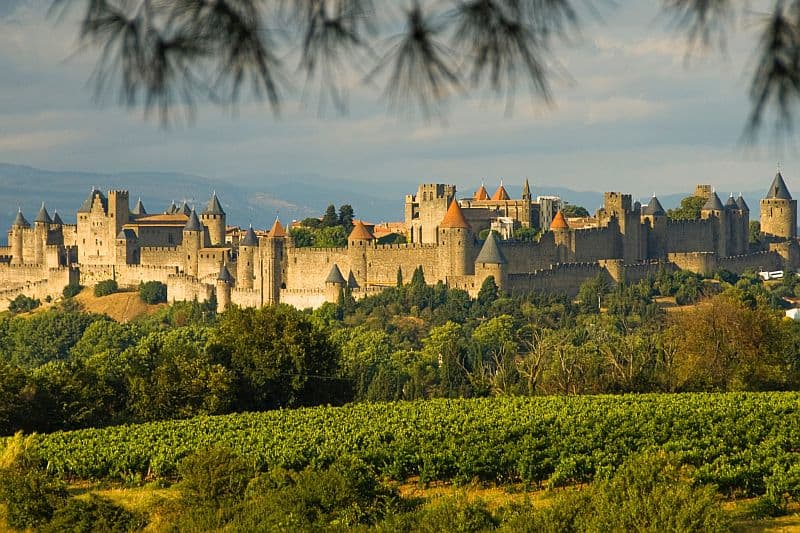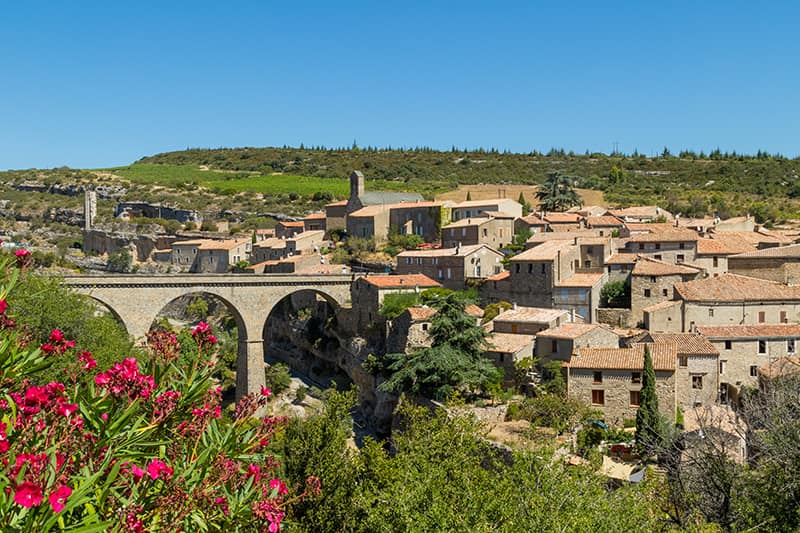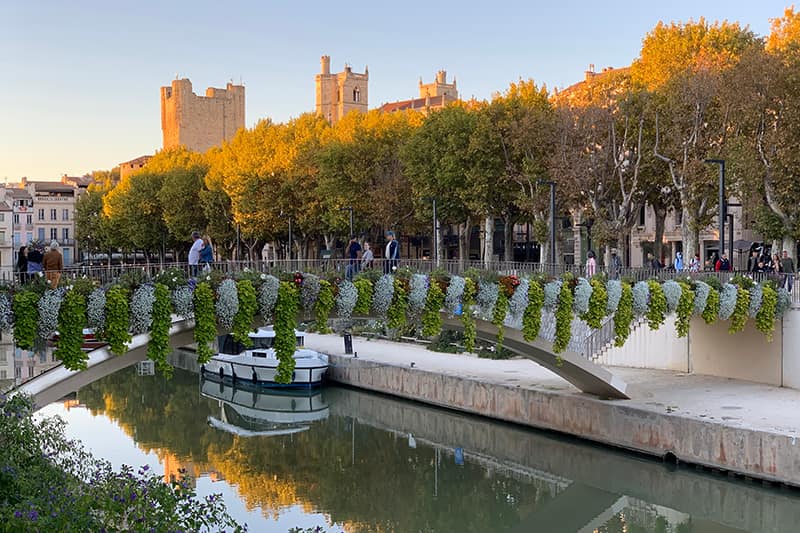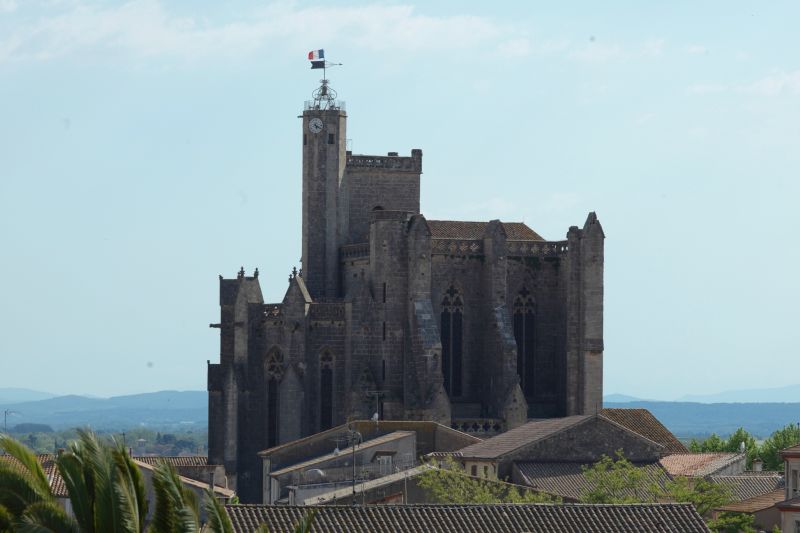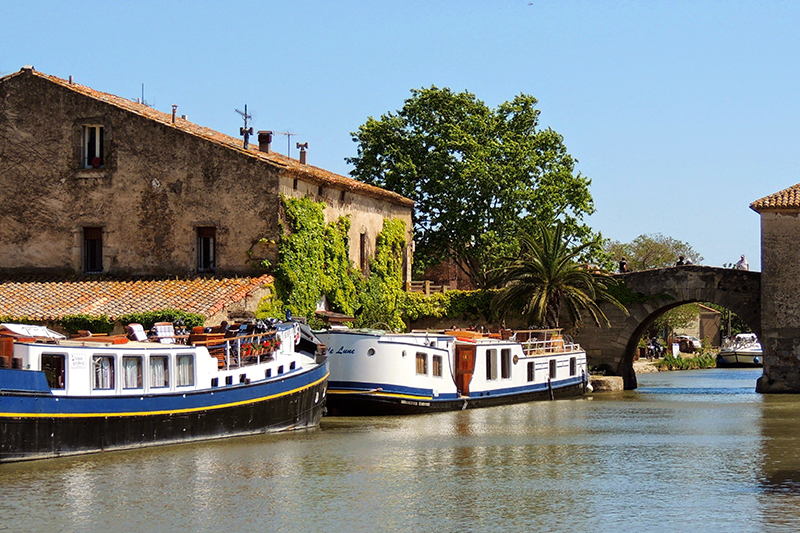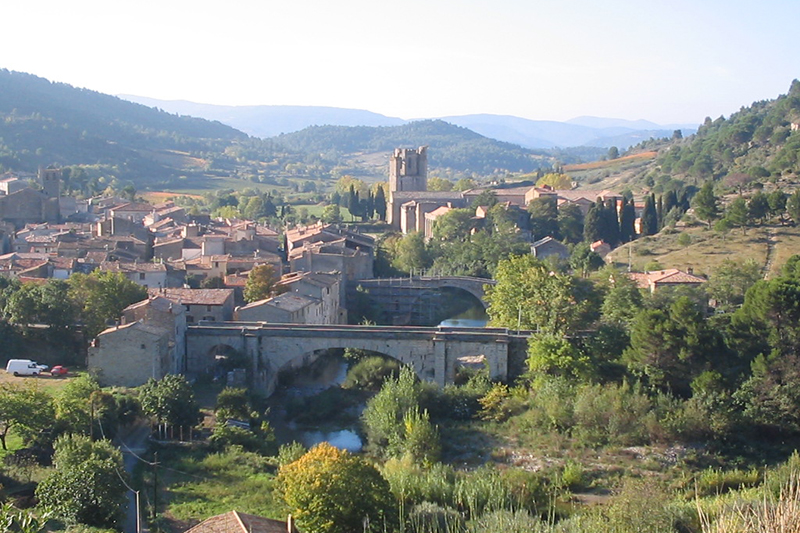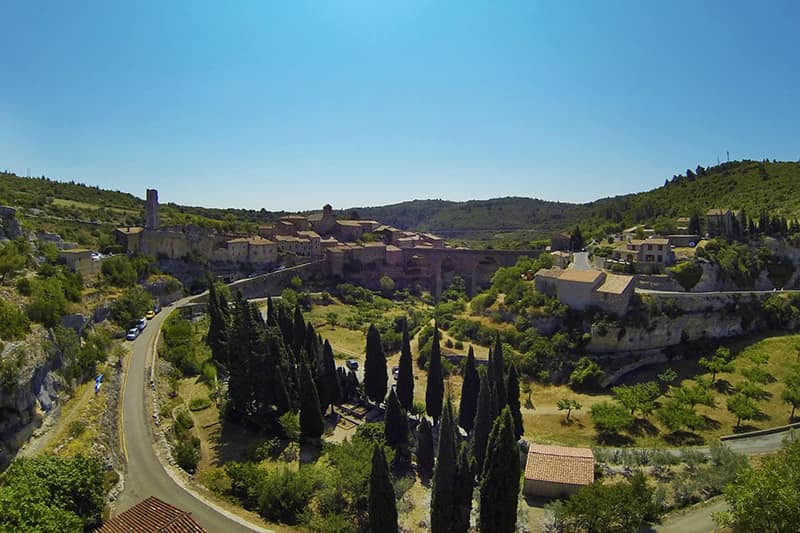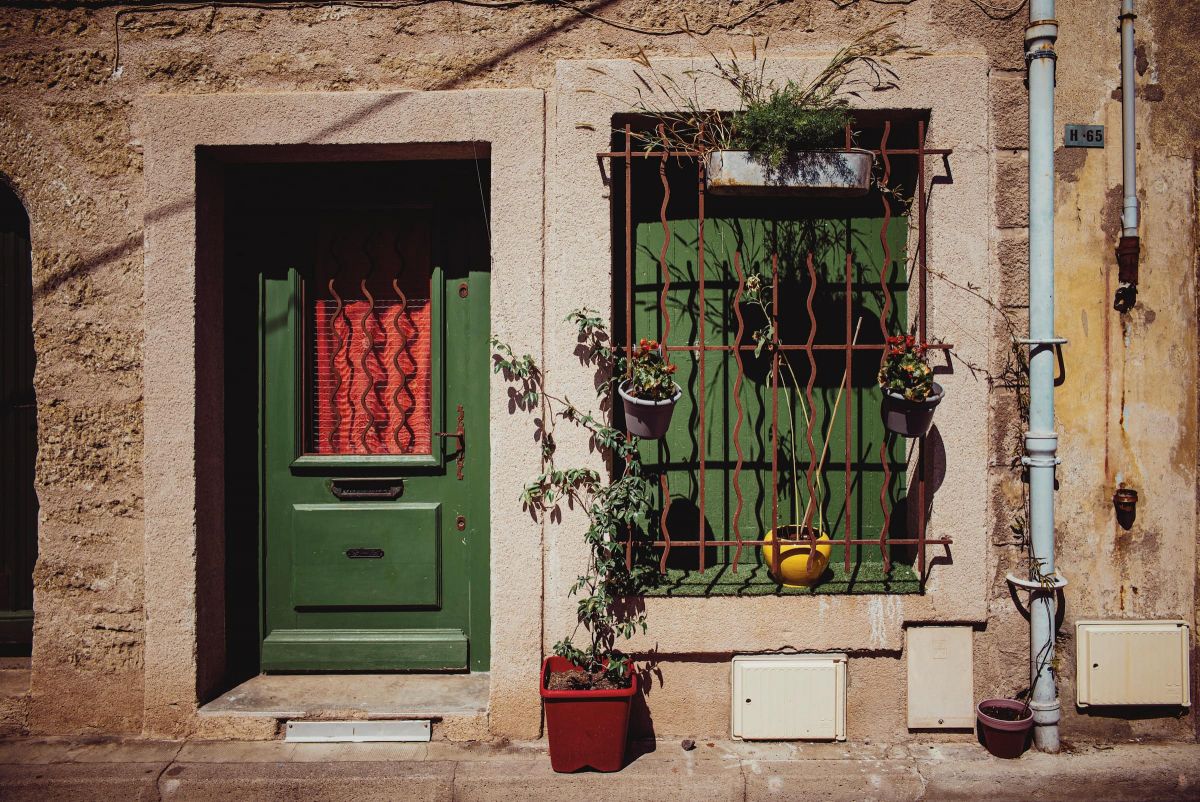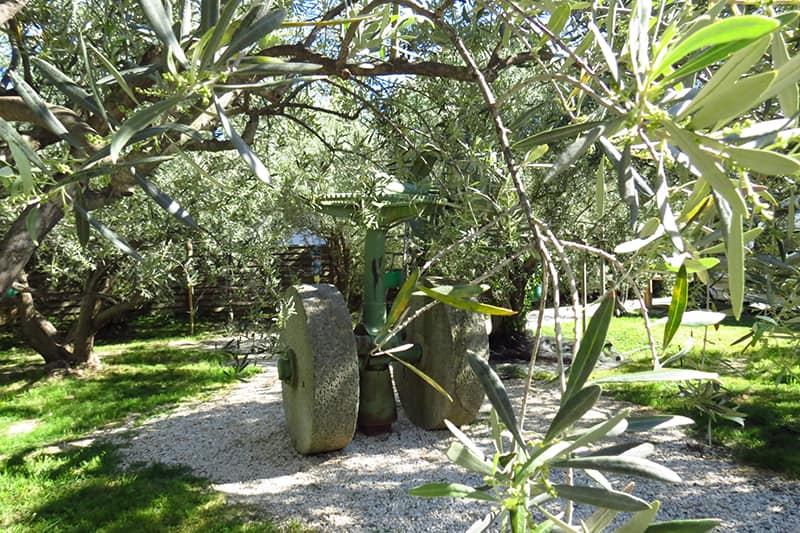At over 340 years old, the Canal du Midi was instrumental to industry in the South of France and is now a celebrated feature of French heritage. Skirting the sun-drenched shore of the Mediterranean, before meandering in land through the fabled Cathar Country, the Canal du Midi passes fortified hilltop villages, miles of unadulterated countryside and orderly vineyards.
If you like the thought of miles of picturesque towpaths and dancing reflections on still water, then make the Canal du Midi your destination of choice this summer. With UNESCO World Heritage status, the Canal du Midi really is the most stunning way to see the South of France.
Carcassonne
Carcassonne is the most impressive medieval fortress in the South of France. Just a ten-minute drive away from the Canal du Midi, this fairy-tale fortified city sits on top of a hill with the Pyrenees Mountains behind it, surveying the surrounding landscape for miles around.
Boasting the longest city wall in Europe, visitors to Carcassonne can walk the battlements to admire the countryside views. Explore the narrow, cobbled streets of the city and find gift shops and cafés to enjoy an iced drink in the shade on hot summer days. Complete your trip to Carcassonne by heading to the historic Pont Vieux bridge on the Aude River, where in the evening, you can see the fortress lit against the night sky.
Béziers
At more than 2500 years old, the hilltop town of Béziers is one of France’s oldest cities. First settled in by the Phoenicians, the town grew to become an important Roman military post.
During this period, Béziers was responsible for exporting wine to Rome. Now known as the wine capital of Languedoc, visitors to Béziers simply must try some local red wine!
Despite experiencing a dark time in the Middle Ages when many if its citizens were murdered, Béziers has a remarkably positive legacy. In the seventeenth century, Béziers resident, Pierre-Paul Riquet, was responsible for envisioning the Canal du Midi, resulting in its construction. Visitors barging the Canal du Midi will be lucky enough to experience the famed nine stepped locks of Fonserannes!
Minerve
Frequently called the ‘most beautiful village in France’, Minerve is a popular stop along the Canal du Midi. Sitting on a rock peninsula above a gorge, the Cesse River runs beneath it and visitors can see its aged bridge. With a population of only about one hundred, this small village is the capital of the Languedoc Minervois wine region. The remains of Minerve’s thirteenth century castle are worth a visit to see tremendous views of deep limestone gorges, and the magnificent surrounding countryside.
However, this quaint fortified village is known for its nasty history. When Cathars from nearby Beziers took refuge at Minerve in 1210, the village was besieged by Simon de Montfort. Though the village held out for six weeks, when the well was destroyed, residents were forced to surrender and 140 Cathars were burned at the stake.
Narbonne
The town of Narbonne is famous for being the first town outside of Italy to be colonised by the Romans, and it grew to become the second largest town in Gaul. Once a coastal port, it prospered until the sea receded in the Middle Ages, making it now eight miles inland. Today, it is accessible via the Canal de la Robine de Narbonne, which is a stone’s throw from the Canal du Midi.
Narbonne is now a pretty French city with a well-restored medieval quarter. The Cathédral St-Just is a must-visit attraction, known for its beautiful stained glass and tapestries, but also renowned as the tallest cathedral in southern France. Close to the cathedral stands the Pont des Marchands, an inhabited bridge, which was built during the Roman Period to carry the Via Domitia over the River Aude. Today it traverses the Canal de la Robine and is listed as a UNESCO World Heritage Site.
Capestang
The town of Capestang is built where once there was a large ‘etang’; a natural lake with shallow water that provided sustenance for the local area in the shape of salt, fish, and wildlife. Transformed by the Archbishops of Narbonne into their summer residence, Capestang grew in the medieval age. It is home to the twelfth century collegial church of St-Étienne.
The Canal du Midi passes to the north of Capestang, which is notable for having one of the lowest bridges on the route. In 1766, a segment of the canal collapsed after heavy rainfall. In the place of the collapsed bank, a siphon sluice was inserted, which became the first of only three on the Canal du Midi.
Le Somail
Le Somail is one of the Canal du Midi’s prettiest villages, and it developed around the building of the canal. This village of the midi was one of many designed and built by Pierre Paul Riquet to help with the commerce and lifestyle surrounding the waterway. It was a resting place for passengers of the mail barge that used the route between Toulouse and Agde in the seventeenth century.
Visitors should see some of the beautiful architectural features of Le Somail, such as the seventeenth century stone-arched bridge, le Pont de St-Marcel, which straddles the canal. An eighteenth-century chapel, which started life as a granary, stands at one end of the canal and opposite it, sits the old ice-house.
Lagrasse
At the foot of the Pyrenees Mountains lies the eighth century village of Lagrasse. This picturesque little settlement is located in the Corbieres wine region, which is known for producing more wine than anywhere else in France. With its old humpback bridge, medieval houses and gothic church, visitors to the Canal du Midi won’t want to miss a detour to Lagrasse.
Lagrasse is home to the Benedictine Abbey of St Mary, which was founded on the bank of the river Orbieu in the 8th century. This architecturally beautiful complex can be explored by visitors, who can see an eleventh century Romanesque church, a marble-sculpted arch in the cloister and a 40-metre-high octagonal bell tower.
Minervois Wine Region
The Canal du Midi passes through the Minervois wine region, which is one of the largest wine growing areas in the Languedoc-Roussillon region. Popular because it produces many different types of wines, it is an excellent location for wine tourism and is well-positioned for a barge stop along the Canal du Midi.
The Minervois wine region is an excellent place to try wine that tastes slightly different. Wines from this area are most commonly red wines and are made from the Grenache, Syrah and Mourdevre grape varieties, but the rarer Lledoner Pelut is also used. A specific characteristic of Minervois wines are the aromas of ripe fruit.
Pézenas
A short drive from the Canal du Midi is Pézenas, a petite city renowned for its innovative and talented artisans who are sculptors, potters, cabinet makers, glassblowers, and so much more. Their work colours this medieval municipality and is featured in an array of beautiful boutiques throughout Pézenas.
This city in the South of France came to the fore in the sixteenth century and later became home to the well-known French actor and playwright, Jean-Baptiste Poquelin, otherwise known as Molière. It is famous for its large houses with tinted shutters and old cobbled streets, having been transformed in the sixteenth century into Languedoc’s very own Versailles.
L'Oulibo
Food lovers visiting the South of France shouldn’t miss an opportunity to visit the olive cooperative at L’Oulibo, which is situated near the banks of the Canal du Midi. With its Mediterranean climate, the region of Languedoc is the perfect place for olives to grow. Founded in 1942, the olives grown at L’Oulibo even proudly display a living heritage label.
Visitors to the Languedoc region can see for themselves how the olives that are picked from the fields are pressed into olive oil through demonstrations. What’s more, L’Oulibo’s farm boutique offers visitors the opportunity to taste the region’s olives, including those from Lucques du Languedoc, which are known as the green diamonds of the region.
Discover the Canal du Midi by hotel barge
To discover the many fascinating towns and villages along the Canal du Midi, why not book a 6-night cruise aboard the 8-passenger Enchanté, the 8-passenger Anjodi, or the 10-passenger Athos. For information delivered to your doorstep, order a free copy of our brochure or perhaps have a no-obligation chat with a member of our team: Contact Form.
 English
English
 Spanish
Spanish French
French German
German Norwegian
Norwegian Portuguese
Portuguese Swedish
Swedish Italian
Italian Russian
Russian Simplified Chinese
Simplified Chinese Japanese
Japanese
